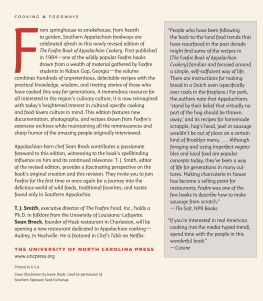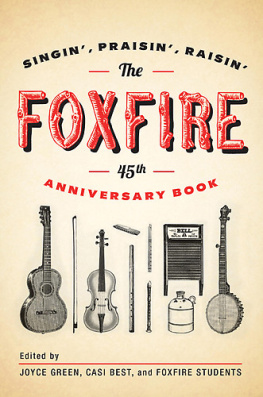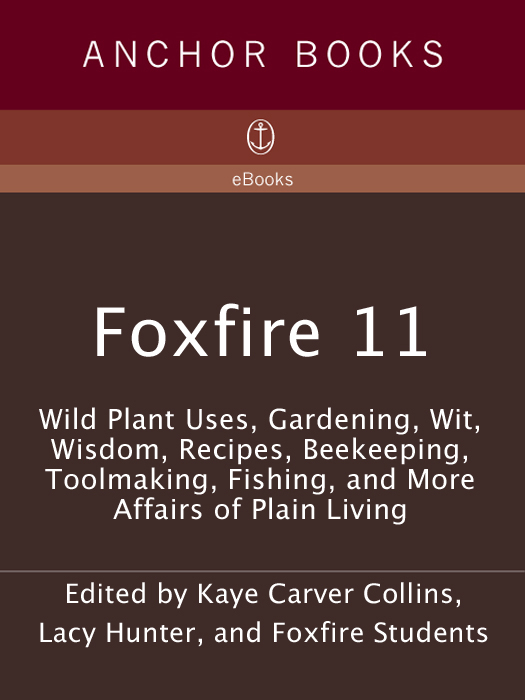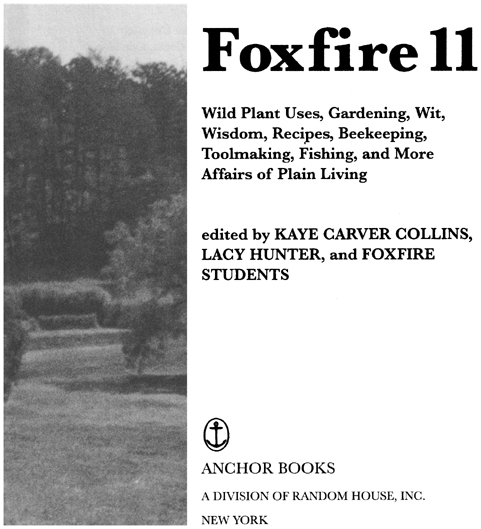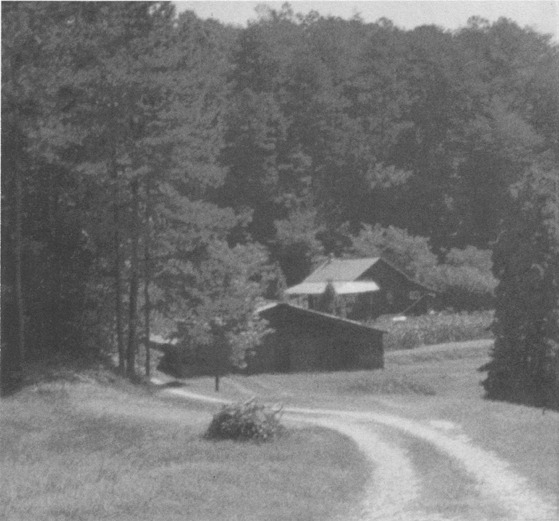This book is dedicated to all the people still searching for their place in the world; to those who have found and cherish their sense of place; and to all the people here in these mountains who have helped us find our place.
ACKNOWLEDGMENTS
W ith any Foxfire project, so many people contribute so much that it would be almost impossible to name and thank all of them individually. We owe so much gratitude to students who, over the years, have gathered the information for the books and made the program a success; to parents who often carry the students on the interviews; and to current teachers Angie Cheek and Joyce Green and Principal Matt Arthur at Rabun County High School, who provide a base of operations and unfailing support and guidance for the magazine program.
In particular, we owe a special thanks to the many people who helped us in the production of Foxfire 11. This book was edited entirely by former students who worked when they came home from college, when they had time off of their regular jobs, or around their other jobs. Without Teresia Gravley Thomason, Amy York, and Robbie Bailey, we could not have finished this book on schedule or with the diversity and perspective it managed to achieve. Teresia, while on summer vacation from her job with Pioneer RESA, produced both the Wild Plant Uses chapter and Wit, Wisdom, and Remembrances, as well as looking at the rest of our sections for grammar and stylistic problems. Amy, who had just graduated from high school and was preparing to go to college, completed the Hunting Stories and Farm Animals chapters. Robbie, the three-time veteran of Foxfire book production, compiled the Fishing and The Old Homeplace chapters and frequently told us what to expect next in the process of compiling the book.
Our help did not just come from former students. Many friends and family members of both the Foxfire 11 crew and the Foxfire program also helped in the production of the book. Bill and Pat Gravley and Jane Thomason and Warren Thomason answered questions on everything from recipes to chickens on a regular basis throughout the summer. For a few weeks, we were at the house of J. C. Stubblefield and Bernice Taylor weekly, conducting interviews for nearly every section of the book. There were days when we called Jimmie and Juanita Kilby several times with questions to which they either had a cheerful answer or did their best to find out for us. Jimmy Hunter read and reread several sections, providing comments, insights, and corrections. Debbie Hunter, Bessie Ramey, and Al Durham gave last-minute advice and help with the recipe section. Former Foxfire students Allison Adams and Teresa Thurmond Gentry helped with final edits.
Various community members also provided needed support. Mildred Donaldson and Susie Smith graciously provided needed information for our Gardens and Commercial Farms chapter. Doug Adams, Kyle Burrell, and Perry Thompson provided needed advice and knowledge regarding the Fishing chapter. Marie Mellinger and Billy Joe Stiles gave invaluable assistance with wild plant names and uses. George and Howard Prater kindly helped us fill in missing information about beekeeping and then sent us away with a few bottles of delicious honey as gifts. Mary Elizabeth Law helped with our research of historical information.
The Foxfire staff, as always, helped when needed. Robert Murray, who could not come near the Foxfire 11 crew without having several questions thrown at him, was always willing to assist. Lila Anna Hiers advertised the coming publication and took numerous pictures for us. Mary Lou Rich did a little of everything, from reading to ordering more supplies, to providing cheerful encouragement and moral support. Michael Buchholz acted as go-between with the Doubleday editors, kept us on task, and helped broaden our perception of what this book could be. Ann Moore read, reread, and read again every page of the book, never complaining, and often encouraging us with everything from words to kind notes left with our sections after she had finished reading them yet again. Bobby Starnes agreed the book should be done and allowed Kaye the time to work on it.
And finally, a heartfelt thanks to the members of our community who welcomed us into their homes and gave freely of their time, their knowledge, and themselves, and, most important, gave us love, friendship, and a sense of belonging. They are the everyday heroes upon which this book and all the others are based. We are indebted to them for raising us right; for supporting us; for showing us that no matter what changes our beloved mountains see, the values and ideas that make us Appalachianthe ones that tell us to be self-sufficient, yet remind us that ultimately we belong to our community and our Creatorwill not change. Thank you.
INTRODUCTION
L ong before my father passed away in 1995 at the age of ninety, he used to boast that he had seen it allfrom the stone age to the atomic agefrom right there in our tall-grass prairie community on the southern plains where he was born, raised, and planned to meet his maker walking out across the pasture. While his story may be unique, it is not out of character for many of Americas elderly whose lives spanned most of the twentieth century. Born in Indian Territory (in Geronimo, no less) and raised among the Comanches, he survived boyhood by farming and hunting the hillsides and creek bottoms on the homeplace. Later he served as Indian agent for the government and, at one time or another after that, was the teacher in a one-room schoolhouse, a threshing crew boss, an oil field roughneck, a sharecropper, a cowboy, and a bulldozer driver. While he was the gentle family patriarch and strongest man in the county to his sons, he was Uncle Cecil to my buddies and cousins who would sit gaped-eyed while he enthralled them for hours with his tall tales of yesteryear. He taught us, among other things, to make our own bows and arrows out of the osage orange tree just like the war chief Great Monsikay taught him, how to predict exactly when a pregnant sow would have piglets, and how to hypnotize a chicken. What neater information could a twelve-year-old boy possibly possess in 1954! This was, of course, before we went forth to the big world and learned to hide our country ways and disguise our Okie accents so we, too, could sound like the man on the six oclock news.
While rummaging through my fathers possessions after the funeral, I discovered something that brought back a flood of memories. There among his few booksBible, various Year Books of Agriculture, and a surveyors handbookwas a water-stained, tattered, and duct-taped copy of the original 1972 Foxfire book. My brother George and his wife, Lynn, had given it to my dad for Christmas that year. As I flipped through the worn, consumed pages with carefully penciled-in personal observation notes in a distinguished handwriting of an earlier generation, I realized that he must have read this Christmas gift at least a hundred times. I remember coming home from Europe that winter to a country and its families torn apart by Vietnam and racial strife. We gathered around the fire on Christmas Eve to admire this most unusual giftand how a high school English class way down in a faraway place called Rabun Gap, Georgia, decided to go out and interview the old people about their traditions as a project in cultural journalism. I now realize that this positive bridging of young and old by the Foxfire kids could not have been better timed for a troubled America. For my father and his generation, the simple fact that their knowledge was appreciated and recorded in black and white was a verification of a hard life well lived. For my part, I momentarily forgot about the generation gap and felt very grateful in being reminded that there was no need to feel shame in this family and rural place. It was one of the happiest Christmases of my life.


